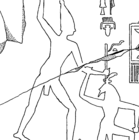Slaying the enemy (Egypt)

As slaying the enemy or slaying the enemy (in the plural), Egyptology describes a certain image program that was part of the standard of royal relief and painting in ancient Egyptian culture . It was supposed to portray and represent the Egyptian king ( Pharaoh ) as invincible conqueror and defender of foreign states together with residents in an idealized form. Therefore, the motive of “slaying the enemy” should be understood more as political propaganda .
Political and cultural background
According to the Egyptian belief, the Pharaoh was regarded as a divine mediator between heaven and earth, but also as a protector and leader of his kingdom. Since he was generally thought to have supernatural properties (for example, that he would return to the gods when he died), one wanted to express the role of the king as protector in the pictorial program of "slaying the enemy". Pictographically, the king was idolized as an invincible conqueror and enemy defender who takes on and drives out every foreign enemy. In the early dynastic period , the motif of “slaying one's enemies” still had some ritual backgrounds, but with the canonization of the show, from the 3rd dynasty at the latest , these gave way to purely political propaganda. This makes it clear that no historical event should be recorded here, as was often assumed in the past. The king is never actually shown directly killing his victim, he merely poses in a superior, intimidating pose.
With this symbolism in mainly figurative form, illiterate people could be intimidated or at least impressed, especially people from hostile areas. For this reason, there are steles , frescoes and pylons from ancient Egypt that show the motif of “slaying the enemy”, heaped up in the border areas of that time, for example with Nubia and Libya . This confirms the meaning and purpose of the motif as a political means of defense against enemies. The motif also appears on pylons and in reliefs of particularly significant temples and palaces, such as the Karnak Temple and Luxor Temple . This was intended to give one's own people a security that only the Pharaoh was able to guarantee.
Documents and forms of presentation

|

|

|

|
| Ornamental palette of Narmer from Abydos (back; detail) | Rock relief of Sanacht from Wadi Maghara (3rd Dynasty) | Sandstone relief of Sneferu (4th Dynasty) | Thutmose III. slays his enemies (Temple of Karnak, 18th Dynasty ) |
Even under King Narmer ( 1st dynasty ) one of the oldest depictions of “slaying the enemy” can be found, engraved on the back of the palette of the Narmer from Abydos . The first canonical elements are already contained here, which, in terms of visual technology, find their completion in the 3rd dynasty . The best-known examples of this are the rock reliefs from the Wadi Maghara of the kings Sanacht , Djoser , Sechemchet (all 3rd dynasty) and Sneferu ( 4th dynasty ). A well-known example from later times is the victory relief of Thutmose III. ( 18th Dynasty ) in the temple of Karnak , on which the ruler kills a whole group of enemies.
The representation of the "slaying the enemy" is basically always the same: The king is holding a heavy ceremonial scepter in his left hand , and with his right hand he has grabbed a stumbling or kneeling enemy by the hair. The king is already striking a fatal blow with the club. The enemy can always be identified as Asian because of his hair and beard , but the enemy himself remains nameless until the Old Kingdom . The king also wears a dagger in his belt and a short apron with an animal tail attached to the back.
The fact that the "slaying of the enemy" is always carried out in the presence of a deity has also been demonstrable since the predynastics, which is reflected in the motif of "presenting the enemy" that emerged in later times (especially since Pharaoh Ramses II , 19th dynasty ) ties in. Here the king is shown how he literally offers subjugated enemies to a god and shows them off.
literature
- Susanne Bickel : In Egyptian company. Aegyptiaca of the Bibles + Orient collections at the University of Friborg Switzerland. Academic Press, Freiburg 2004, ISBN 3-7278-1429-2 , p. 34.
- Renate Müller-Wollermann : Symbolic representation of violence in ancient Egypt. In: Martin Zimmermann (Ed.): Extreme forms of violence in pictures and text of antiquity (= Munich studies on the old world. Vol. 5). Herbert Utz, Munich 2009, ISBN 978-3-8316-0853-9 , pp. 47-64.
- Christian E. Schulz: External relations of Egypt during the 3rd dynasty . GRIN-Verlag, Munich 2007, ISBN 978-3-638-75868-0 , pp. 6-9.
- Anthony J. Spalinger: Some Notes on the Battle of Megiddo and Reflections on Egyptian Military Writing. In: Communications from the German Archaeological Institute, Cairo Department. (MDAIK). Vol. 30, 1974, ISSN 0342-1279 , pp. 221-229.
- Toby AH Wilkinson : Early Dynastic Egypt. Routledge, London et al. 1999, ISBN 0-415-18633-1 , p. 191.
Individual evidence
- ↑ See Abeer El-Shahawy: The Egyptian Museum in Cairo. A walk through the alleys of ancient Egypt. Photographs by Farid Atiya. Farid Atiya Press, Cairo 2005, ISBN 977-17-2183-6 , p. 45, fig. 21.